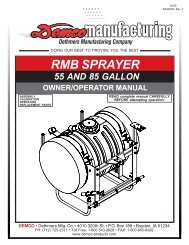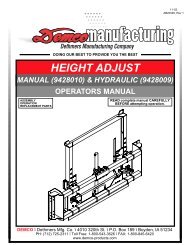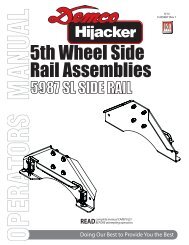RD20017 - Kar Kaddy 3 Operators Manual - Demco Products
RD20017 - Kar Kaddy 3 Operators Manual - Demco Products
RD20017 - Kar Kaddy 3 Operators Manual - Demco Products
Create successful ePaper yourself
Turn your PDF publications into a flip-book with our unique Google optimized e-Paper software.
TOW DOLLY USER GUIDEWARNING: Read the following information completely before hooking up, loading, usingunloading or unhooking this Tow Dolly.FAILURE TO FOLLOW THESE SAFETY INSTRUCTIONSMAY LEAD TO DAMAGE TO PROPERTY, SEVERE PERSONAL INJURY, AND/OR DEATH.• Read towing instructions in towed vehicle’s owner’s manual.• Read towing instructions in towing vehicle’s owner’s manual. Be certain that your towing vehicle has the capacityto tow a tow dolly and towed vehicle combination. IF YOU HAVE ANY QUESTIONS ABOUT THIS, DO NOT TOW.CONSULT YOUR DEALER OR CALL DEMCO.• Use a 2”, 6000 lb. (or greater) capacity ball for a tow dolly.• Make sure towing vehicle’s parking brake is fully engaged before starting hookup, loading, unloading, or unhooking oftow dolly.• Do not load towed vehicle onto tow dolly until tow dolly is completely and properly hooked up to towing vehicle andsetting on a level surface.• Tail lights and stop lights must be hooked up and operating properly at all times.• Do not load a towed vehicle that exceeds weight or size limits of tow dolly.• Always have someone safely guide you when driving towed vehicle onto tow dolly.• Be sure tires of your towed vehicle and tow dolly are in good condition and inflated to proper pressures. Tire pressuremay increase during travel—do not bleed off extra pressure.• Do not back up your towing vehicle when a tow dolly is attached. A tow dolly swivels both at the coupler and at carplatform. If you must back up, unload towed vehicle first, disconnect tow dolly and move vehicle and tow dolly separately.Park where you can pull ahead when leaving.• Do not exceed 55 miles per hour, or any lower posted speed limit.• Avoid sharp turns or swerves.• Braking distance increases when using a tow dolly. Use caution and always allow sufficientdistance for braking.• Do not transport passengers or cargo in vehicle being towed.• Do not unhook tow dolly from towing vehicle until towed vehicle is completely unloaded from tow dolly.• Allow one tow-vehicle/tow dolly/vehicle-in-tow length for each 10 m.p.h. behind another vehicle.• ALWAYS check the hitch, tow dolly and vehicle-in-tow at each stop to insure that coupling, chains and tie down equipmentremain tight and properly attached. Use tow dolly checklist as an aid.• NEVER tow without properly installed tire straps and security chains properly attached to frame or other structural memberof vehicle-in-tow.• ALWAYS slow down—40 miles per hour or less—for curves, wet or rough roads, and downgrades. On downgrades,shift into a lower gear and allow engine to help hold speed down.• ALWAYS be rested. NEVER drive when fatigued.• AVOID driving at night. Night drivers have three times the fatality rate of day drivers.• NEVER continue to operate an unstable (swaying or whipping) combination. If this occurs, slowly pull over, reducingspeed through your engine rather than braking. When stopped in an off the road location check hitch, tire straps, andchains.• NEVER pass on hills or curves. Beware of cross winds and wind gusts from passing vehicles.• NEVER transport passengers or cargo in towed vehicle.• ALWAYS load vehicle-in-tow facing forward. NEVER back onto tow dolly. For maximum stability steering axle must beon tow dolly.Page 5
















